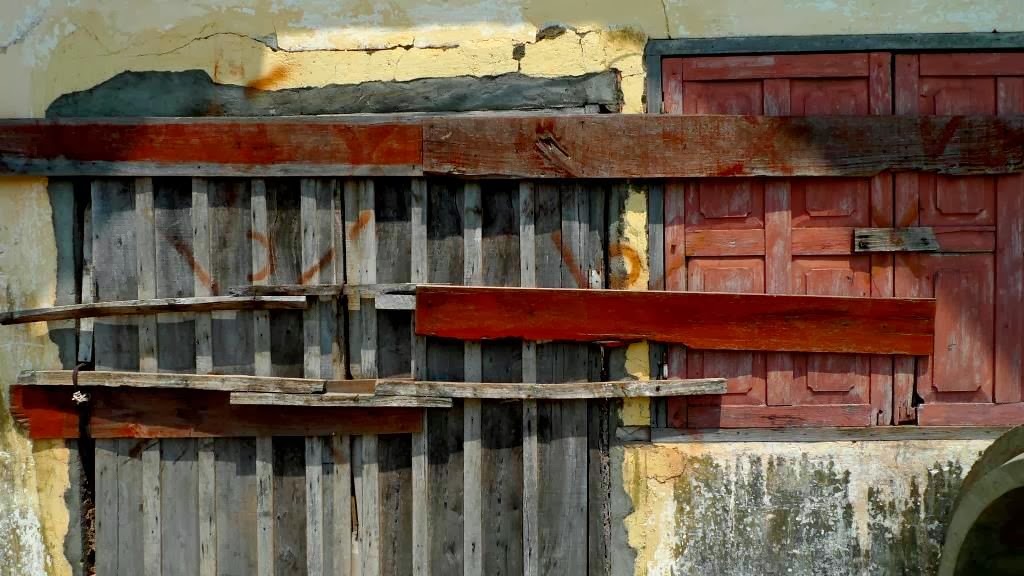22. Chemin de Fer de Cambodge Stations
The railway stations in Sihanoukville, Kampot and the rural station at Tuek Thla
One last look at the remaining structures for the Cambodian railway, designed and build by French engineers and architects during the second French protectorate period. Today the stations range from being in a restored, good, to an acceptable state, such as the central railway station in Phnom Penh (recently closed to visitors, since it is the staging site for military riot police) and the station in Battambang (closed) (Both: See earlier posts), to the structures in a severely dilapidated, yet salvageable state, such as the stations in Sihanoukville and Kampot, to the ones which are lost forever. Of those I saw only the rural station in Tuek Thla, some 17 kilometers west of the town of Kampot. I am sure there are many more, more to explore during a next trip!
Sihanoukville
An excellent, interesting and environmentally fully adapted building, influenced not only by le Corbusier's architecture, but maybe also by Kahn and his engineer August Komendant's Kimbell Art Gallery, Fort Worth, Texas; although the hiring of the architect and the design of this building was only begun in 1966.
The Sihanoukville railway station was designed and built by Georges Kondracki and Guy Lemarchand, and completed in 1969. It was the last of three major train stations built as part the construction of the Phnom Penh - Sihanoukville rail link constructed between 1960 and 1969. A barrel vaulted concrete roof covers the entire building and gives it a strong 'Mediterranean' feel. The vaults form also a secondary roof layer, providing lower heat loads on the actual roof below. They are open for transverse airflow. The main hall is semi-enclosed by a full-height steel grate structure which allows the breezes to cool the interior. There is no glass used in the enclosure. The hall is a simple rectangle with an architectural staircase at one end providing a focal point as well as access to the railway office functions on the second floor.
Today the building is in part being used by poor squatter families who occupy the former platform offices, facing the tracks.
I mentioned the Kampot station in an earlier post, but since it is such a good building I thought it justifies showing some more images. The symmetrical layout has a pyramidal roof structure in its center, indicating the main hall which is fully open to the breezes. The sheet metal covering of the pyramidal roof is heavily corroded. Originally, there must have been rolling gates, or a steel door system enclosing the ticket hall, however only traces of the former tracks can be found in the badly damaged tile floor today. The station is closed, there is no passenger train service out of Kampot, or Sihanoukville, since 2006. The building's two folded-plate roof wings house the former support functions and freight offices. All of those are boarded up.
 |
| Former ticket counters. |
Rural train stop and former station in Tuek Thla, Kampot Province
This is a hard to find station in the countryside, some 300 meters off Highway 3 from Sihanoukville to Kampot. There is no path or driving access from the highway, one has to hike through the bushes to find the ruin. This makes also for interesting encounters with bugs and fire ants which fall miraculously from the branches and like to latch on to your skin. They are easily brushed off, though.
The building design is very simple yet beautiful. A thin cast-in-place frame, previously holding a flat roof forms the main arrival and departure space. There was most likely no enclosure. The elongated hall is followed by a compact walled set of simple rooms for the railway office functions. On the far end are the toilets. Window openings have additional separated, permanent cross-ventilation slots added on top. This is a detail which can be seen throughout French designs in Cambodia, for apartments or in this case for offices.
The setting is actually quite beautiful with Bokor National Forests and the mountains in the background.
 |
| Window, most likely formerly englazed, with top ventilation slot. |


















No comments:
Post a Comment